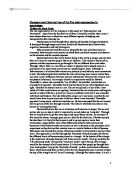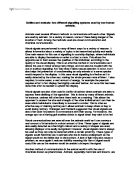Once I believed the two rodents to be different species, I began to observe them more closely and record similarities and differences between them. There were several characteristics in which the populations differed. The average mass of the St. Kitt’s rodent was 83g, while it was 86g for the rodent from Nevis. The average length of the rodents from St. Kitt’s was 21.8 cm, with the average length of the Nevis rodents 23.3 cm. The St. Kitt’s rodent had an average hind limb length of 7.8 cm, while the Nevis rodent’s hind limb had an average of 4.2 cm. The lengths of the forelimbs also differed, with the St. Kitt’s average being 4.2 cm and the Nevis average 3.9 cm. The St. Kitt’s rodents were much faster, with an average top speed of 2.2 m/s, while the Nevis rodents could only run at an average of 0.8 m/s. The St. Kitt’s rodent had an average leap height of 1.4m, while the Nevis rodent could only leap about 0.4m. There was also a difference in gestation time, as the average pregnancy for a St. Kitt’s rodent was 29.3 days, and for a Nevis rodent it was 42.7 days. Finally, the average time spent in courtship display by the St. Kitt’s rodent was 12.6 seconds, while it was 21.3 seconds for the Nevis rodent. Based on the data observed, it is easy to see that the St. Kitt’s and Nevis rodents are two very differently adapted populations, if not different species all together.
In order for speciation or macroevolution to occur, many microevolutionary changes must accumulate in a population. Micorevolutionary changes are changes that occur in the allele frequencies of a population.(1) There are five different conditions that must be maintained in order for microevolutionary changes not to occur. The conditions are: no genetic drift, no gene flow, no gene mutations, no natural selection, and random mating. If all five conditions are met, allele frequencies within a population will remain constant and microevolution will not occur.(2) Based on my observations and research, I believe that the microevolutionary changes that occurred in the two populations of rodents were mutation and natural selection.
When random mutations occur in gametes, the offspring produced by the gametes will have different characteristics than other offspring. If the mutation is advantageous to the individual, natural selection can occur.(2) Natural selection is dependent upon genetic variation. Because of the variation present in all populations, certain individuals have more advantageous characteristics than other individuals. These advantaged individuals are more likely to survive to reproducing age and to pass on their characteristics to their offspring, while the other individuals not possessing the advantageous characteristic will find it more difficult to obtain the necessities of life, and reproduce. Over several generations, the majority of the population will possess the advantageous trait, and those more possessing it will have died off.(2)
In the case of the rodents on the islands, mutations and natural selection created differences in the two species. On the island of St. Kitt’s, about 20, 000 years ago, there was a wolf-like predator that preyed on the rodents. This predator acted as a natural selector and was responsible for the changes that occurred in the St. Kitt’s rodent population. The predator was more likely to catch and eat slower individuals within the rodent population. Mutations that created faster rodents were advantageous because the faster rodents were more likely to survive to reproducing age, and could pass on their fast characteristics to their offspring. As fewer slow rodents survived to reproducing age, over many generations, the majority of the population became faster, increasing the average speed of the population of rodents. As mutations and natural selection can be considered interdependent, mutations were responsible for the appearance of all new traits in the population. The predator of the rodents was a terrestrial animal that did not live in, or climb trees. Because of this characteristic, rodents with longer hind limbs, who could leap higher into the air, grasping tree branches to escape from the predator, were more likely to survive than individuals whose legs were too short, and could not jump high enough to avoid being caught. In addition, smaller rodents were better able to hide and appear inconspicuous to a predator; the larger rodents were more likely to be eaten. In an environment with a dangerous predator, life spans are generally shorter, and it is more advantageous for courtship rituals and gestation periods to be shorter, allowing for more rapid reproduction of offspring, continuing the existence of the species. Based on the data observed, and the conclusions made, it is clear that the St. Kitt’s rodent has evolved, by mutations and natural selection, in response to the pressure of a predator in the environment. The Nevis rodent did not have this same pressure, and it therefore did not evolve in the same way, because environmental pressures had already naturally selected its population before it had been separated from the population on St. Kitt’s.
The differences in the two populations would never have come about, despite the microevolutionary changes on St. Kitt’s, if it were not for the allopatric speciation of the two populations. Allopatric speciation sets up a geographical barrier that blocks the gene flow between two populations. Due to the prevention of gene flow, microevolutionary changes accumulate independently in each population. If the accumulated changes are sufficiently different, they may result in the development of two different species.(1) St. Kitt’s and Nevis were once connected to each other, and the rodent populations of both regions were the same species, and shared a common gene pool. When the single island split into two, the rodent populations were separated from each other by allopatric speciation. As gene flow was blocked between the two populations, they accumulated microevolutionary changes independently of one another. The rodents of St. Kitt’s were naturally selected by a predator, and their microevolutionary changes accumulated to create a new species, no longer capable of mating with the parent species of Nevis.
Once the two populations were recombined, they remained unable to produce viable, fertile offspring because of different reproductive isolations. The rodents populations from the two islands are reproductively isolated behaviourally. Behavioural isolation involves the difference courtship rituals used by animals to attract a mate. The rodents of St. Kitt’s have a much shorter courtship ritual than the rodents on Nevis, and the behaviour would be unlikely to attract an individual from the other species. This isolation furthers the blockage of gene flow between the two populations, and keeps the gene pools of the populations separate.
In order to understand why the two rodent populations could not mate with each other, I needed to understand microevolution, macroevolution, and reproductive isolations. To summarize, the geographic division or allopatric speciation set up the possibility of the creation a new species, and it was the accumulation of the microevolutionary changes in the populations that eventually led to the development of a unique species, some 15, 000 years later. Once the new species had developed, after recombining with the parent species, they could not successfully mate because of the behavioural reproductive isolation.
References
- Davis, Seonaid. SBI4U Course Notes 2004-2005.
-
Campbell and Reese. 2002. Biology Sixth Edition. San Francisco: Benjamin Cummings.
-
Rodent. [Online Image] Available: , December 7, 2004.







